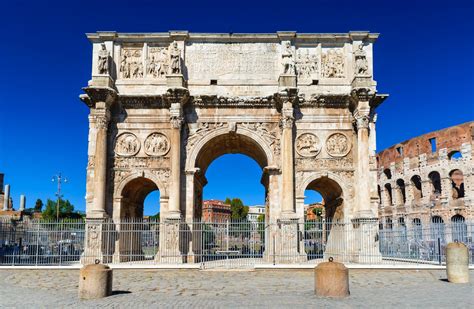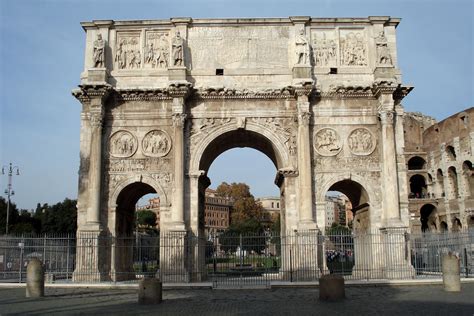Arch Of Constantine

The Arch of Constantine, situated in the heart of Rome, is one of the most iconic and historically significant monuments in the world. Constructed in 315 AD, this triumphal arch commemorates the victory of Constantine the Great over Maxentius at the Battle of Milvian Bridge in 312 AD, a pivotal moment in Roman history that marked the beginning of Constantine's reign and the eventual rise of Christianity as a dominant force in the empire. The arch stands as a testament to the engineering prowess and artistic flair of the ancient Romans, with its intricate carvings, imposing structure, and strategic location along the Via Triumphalis, the route taken by Roman armies during their triumphant processions into the city.
From a historical perspective, the Arch of Constantine is a treasure trove of information, offering insights into the political, social, and cultural landscape of ancient Rome during the 4th century AD. The arch's design and construction reflect the transition from the classical Roman style to a more austere and simplistic approach, characteristic of the late Roman Empire. The monument's friezes, which depict scenes from Constantine's military campaigns and public life, provide a unique window into the emperor's propaganda efforts and his attempts to legitimize his rule. Furthermore, the arch's incorporation of sculptures and reliefs from earlier Roman monuments, such as the Arch of Trajan and the Forum of Trajan, highlights the complexities of Roman artistic and cultural production during this period.
Key Points
- The Arch of Constantine was constructed in 315 AD to commemorate Constantine's victory over Maxentius at the Battle of Milvian Bridge.
- The arch is a significant example of Roman engineering and artistic skill, with its intricate carvings and imposing structure.
- The monument's design and construction reflect the transition from classical Roman style to a more austere and simplistic approach, characteristic of the late Roman Empire.
- The arch's friezes provide valuable insights into Constantine's military campaigns, public life, and propaganda efforts.
- The incorporation of sculptures and reliefs from earlier Roman monuments highlights the complexities of Roman artistic and cultural production during the 4th century AD.
The Historical Context of the Arch of Constantine

The Arch of Constantine was built during a time of great turmoil and transformation in the Roman Empire. Constantine’s victory over Maxentius marked the end of a period of civil war and paved the way for the emperor’s efforts to reform and reorganize the empire. The arch’s construction was likely part of a broader campaign to promote Constantine’s image and legitimize his rule, and its design and decoration reflect the emperor’s attempts to appeal to different segments of the Roman population. The arch’s location, situated between the Colosseum and the Roman Forum, also highlights its importance as a symbol of imperial power and authority.
The Design and Construction of the Arch
The Arch of Constantine is a triple-arched monument, with a central arch flanked by two smaller arches. The arch is constructed from white marble and stands over 21 meters tall, making it an imposing presence in the Roman landscape. The arch’s design is characterized by a mixture of classical and late Roman elements, with a focus on simplicity and functionality. The arch’s friezes, which depict scenes from Constantine’s military campaigns and public life, are a key feature of the monument and provide valuable insights into the emperor’s propaganda efforts.
| Architectural Feature | Description |
|---|---|
| Material | White marble |
| Height | 21 meters |
| Design | Triple-arched, with classical and late Roman elements |
| Friezes | Depict scenes from Constantine's military campaigns and public life |

The Significance of the Arch of Constantine

The Arch of Constantine is more than just a historical monument – it is a testament to the enduring legacy of the Roman Empire and its continued influence on modern society. The arch’s design and construction reflect the cultural, artistic, and architectural achievements of the ancient Romans, and its historical significance extends far beyond its function as a triumphal arch. The arch has been the subject of numerous studies and interpretations over the years, and its significance continues to be felt in fields such as architecture, art history, and classical studies.
In addition to its historical and cultural significance, the Arch of Constantine is also an important symbol of Rome's rich cultural heritage. The arch has been the subject of numerous restoration and conservation efforts over the years, and it continues to be an important tourist destination and cultural landmark. The arch's significance extends beyond its physical presence, however, and its influence can be seen in countless works of art, literature, and architecture throughout history.
The Legacy of the Arch of Constantine
The Arch of Constantine has had a profound impact on the development of Western art and architecture, and its influence can be seen in countless works of art and architecture throughout history. The arch’s design and construction reflect the cultural, artistic, and architectural achievements of the ancient Romans, and its historical significance extends far beyond its function as a triumphal arch. The arch has been the subject of numerous studies and interpretations over the years, and its significance continues to be felt in fields such as architecture, art history, and classical studies.
What is the historical significance of the Arch of Constantine?
+The Arch of Constantine is a historically significant monument that commemorates the victory of Constantine the Great over Maxentius at the Battle of Milvian Bridge in 312 AD. The arch is a testament to the engineering prowess and artistic flair of the ancient Romans, and its design and construction reflect the cultural, artistic, and architectural achievements of the ancient Romans.
What is the design and construction of the Arch of Constantine?
+The Arch of Constantine is a triple-arched monument, with a central arch flanked by two smaller arches. The arch is constructed from white marble and stands over 21 meters tall, making it an imposing presence in the Roman landscape. The arch’s design is characterized by a mixture of classical and late Roman elements, with a focus on simplicity and functionality.
What is the significance of the Arch of Constantine in modern times?
+The Arch of Constantine is a significant cultural landmark and tourist destination, and its influence can be seen in countless works of art, literature, and architecture throughout history. The arch is a testament to the enduring legacy of the Roman Empire and its continued influence on modern society.



